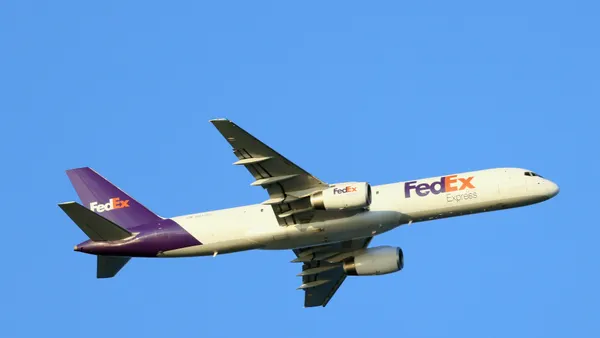Dive Brief:
- FedEx suspended 2020 guidance due to uncertainty created by COVID-19, the company announced in an earnings release and subsequent conference call Tuesday.
- CEO Fred Smith said the company would be "attacking costs" in order to insulate from the uncertainty brought on by the pandemic. But FedEx has been in cost-cutting and efficiency-seeking mode for several quarters, as it seeks to recapture tumbling profitability. The carrier has pledged to cut air freight capacity since September and said Tuesday it would retire even more planes going forward. More savings will come from existing bets such as insourcing SmartPost volume, transferring residential Express volume into the Ground network and completing the integration of TNT Express, which it acquired in 2016, executives said.
- Bright spots for the carrier include East-West air freight routes, which became essential amid China's aggressive response to COVID-19, an illness in the coronavirus family, and FedEx Freight. Income from FedEx's LTL and big and bulky delivery segment grew 16% year-over-year in the quarter.
Dive Insight:
Total air cargo capacity out of China was down 40% year-over-year in early March, said FedEx Chief Marketing and Communications Officer Brie Carere, adding the carrier instituted a peak surcharge on U.S. bound flights out of China as a way of managing the influx of demand amid limited capacity.
"With the urgent need for stock replenishment, and with air capacity shortage in the market, we believe demand will stay elevated. We continue to adjust transit times and spot prices specifically for China outbound to manage demand profitably," she said.
As the epicenter of the pandemic shifts West, the carrier will replicate its moves in China elsewhere, though reducing overall airfreight capacity is still part of the cost-cutting plan. The company is "now employing the same strategies in other parts of the world that have helped us manage demand and capacity constraints in China," including transit time extensions and dynamic spot-price management. FedEx will also leverage peak surcharges for specific lanes and periods of time as required, Carere said.
The cost-savings efforts FedEx named on the call were all previously announced and resulted in a point of contention between executives and analysts: the simple math surrounding these changes and whether they would generate the savings promised.
Regarding SmartPost, for example, Barclay's analyst Brandon Oglenski asked if the increased delivery density FedEx used as its justification for integrating SmartPost could really drive savings when a "$5 product [is] effectively now being served by an $8 network?"
CFO Alan Graf, set to retire in September, insisted the move is the right one. "Every time we have a match or a near match of the SmartPost package in our Ground network, our costs are significantly below the postage for SmartPost. So, it's just math," Graf said. Parcels weighing under one pound will continue to be outsourced to USPS, Carere added.
"We didn't insource SmartPost because we felt it was a good idea. We did it because the basic math said that we should and with this Tier-1, short-haul e-commerce, we think we can be the low-cost producer and the market leader there," added Smith.
The company announced the shift in May, and now nearly at the one-year mark, the efficiency has not yet realized on the balance sheet.
The consolidated operating margin for the third quarter (ending Feb. 29) was less than half what it was a year earlier, mirroring margin erosion in the second quarter. Quarterly operating margin for the Ground segment went from 11.1% in Q3 2019 to 6.1% in Q3 2020.
The carrier did post some top-line growth with 3% consolidated revenue growth for the quarter year-over-year, which it credited to Ground volume growth.
But executives listed several events, which FedEx previously called less-than-significant to the balance sheet, as headwinds in the last nine months — namely FedEx's spiky relationship with Amazon.
FedEx ended its air freight relationship with Amazon last year, but held onto some ground volume until Amazon briefly banned third-party marketplace sellers from using the carrier in December for what it described as a "decline in performance." According to Graf, the loss of volume was no meer scratch. In addition to the Amazon issue, the carrier's shift to seven-day service, which will hit the one-year mark in May, continues to boost operating costs and will do for at least the next quarter, Graf said.
"The combination of headwinds of the expansion to six- and seven-day delivery and the loss of the Amazon volume negatively impacted Ground margins by approximately 190 basis points," said Graf.












